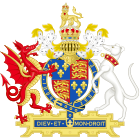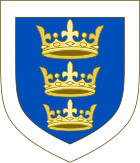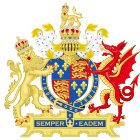Acts of Supremacy

The Acts of Supremacy are two acts passed by the Parliament of England in the 16th century that established the English monarchs as the head of the Church of England; two similar laws were passed by the Parliament of Ireland establishing the English monarchs as the head of the Church of Ireland. The 1534 Act declared King Henry VIII and his successors as the Supreme Head of the Church, replacing the Pope. This first Act was repealed during the reign of the Catholic Queen Mary I. The 1558 Act declared Queen Elizabeth I and her successors the Supreme Governor of the Church, a title that the British monarch still holds.
Royal supremacy is specifically used to describe the legal sovereignty of the king (i.e., civil law) over the law of the Church in England.[citation needed][1]
First Act of Supremacy 1534
[edit]| Act of Parliament | |
 | |
| Long title | An Act concerning the King's Highness to be Supreme Head of the Church of England, and to have Authority to reform and redress all Errors, Heresies and Abuses in the same. |
|---|---|
| Citation | 26 Hen. 8. c. 1 |
| Dates | |
| Royal assent | 18 December 1534 |
| Repealed | 1555 |
| Other legislation | |
| Repealed by | See of Rome Act 1554 |
Status: Repealed | |
The first Act of Supremacy, passed on 3 November 1534 (26 Hen. 8. c. 1) by the Parliament of England[2] was one of the first major events in the English Reformation. It granted King Henry VIII of England and subsequent monarchs royal supremacy and stated that the reigning monarch was the supreme head of the Church of England.
The Act declared that the king was "the only supreme head on Earth of the Church of England" and that the Crown shall enjoy "all honours, dignities, preeminences, jurisdictions, privileges, authorities, immunities, profits, and commodities to the said dignity."[3] The wording of the act made clear that Parliament was not granting the king the title (thereby suggesting that they had the right to withdraw it later); rather, it was acknowledging an established fact. In the Act of Supremacy, Henry VIII withdrew support for the authority of the pope and the Roman Catholic Church and asserted the independence of the Ecclesia Anglicana. He appointed himself and his successors as the supreme rulers of the English church. Earlier, Henry VIII had been declared "Defender of the Faith" (Fidei defensor) in 1521 by Pope Leo X for his pamphlet accusing Martin Luther of heresy.[4] Parliament later conferred this title upon the king in 1544.[5]
Henry VIII was motivated to issue the Act for multiple reasons. He desperately wanted a male heir to continue his line, and after wars and succession crises, aimed to ensure that his dynastic lineage would continue without challenge. When Catherine of Aragon did not bear a son, the king tried for years to annul his marriage to her, having convinced himself that God was punishing him for marrying his brother's widow.[6]
Despite his close alignment with the Catholic Church and other papal annulments,[citation needed] Pope Clement VII refused to grant Henry VIII an annulment. Roman Catholic doctrine viewed a marriage contract as indissoluble until death, and the papacy argued that a marriage could not simply be annulled because of a canonical impediment previously dispensed.[7] Additionally, the emperor of the Hapsburg empire at this time was the nephew of Catherine of Aragon, and for the pope to declare that marriage invalid would be to separate the Church from the good favor of the emperor.[citation needed]
Henry VIII subsequently passed the Treasons Act, which stated that to disavow the Act of Supremacy and to deprive the king of his "dignity, title, or name" was to be considered treason.[8] Thus, the king's control over the English religion was absolute and those who held to Catholic beliefs were swiftly punished. The most famous public figure to resist the Treasons Act was Sir Thomas More, who was convicted of treason and executed by beheading.[9]
Irish Act of Supremacy 1537
[edit]| Act of Parliament | |
 | |
| Long title | An Act authorizing the King, His Heirs, and Successors, to be supreme Head of the Church of Ireland. |
|---|---|
| Citation | 26 Hen. 8. c. 5 (I) |
| Other legislation | |
| Repealed by | Statute Law Revision Act 1950 |
Status: Repealed | |
In 1537, the Act of Supremacy (Ireland) 1537 (28 Hen. 8. c. 5 (I), An Act authorising the King, His Heirs and Successors, to be supreme Head of the Church of Ireland) was passed by the Parliament of Ireland, establishing Henry VIII as the supreme head of the Church of Ireland, as had earlier been done in England.[10]
Second Act of Supremacy 1558
[edit]| Act of Parliament | |
 | |
| Long title | An Acte restoring to the Crowne thauncyent Jurisdiction over the State Ecclesiasticall and Spirituall, and abolyshing all Forreine Power repugnaunt to the same. |
|---|---|
| Citation | 1 Eliz. 1. c. 1 |
| Other legislation | |
| Repeals/revokes | Suppression of Heresy Act 1400 |
Status: Amended | |
| Revised text of statute as amended | |
Henry VIII's Act of Supremacy was repealed in 1554 during the reign of his staunchly Roman Catholic daughter, Queen Mary I. Upon her death in November 1558, her Protestant half-sister Elizabeth I succeeded to the throne. The first Elizabethan Parliament passed the Act of Supremacy 1558[nb 1] that declared Elizabeth the Supreme Governor of the Church of England and instituted an Oath of Supremacy requiring anyone taking public or church office to swear allegiance to the monarch as head of the Church and state. Anyone refusing to take the oath could be charged with treason.[13]
The use of the term Supreme Governor as opposed to Supreme Head pacified some Catholics and those Protestants concerned about a female leader of the Church of England. Elizabeth, who was a politique,[citation needed][14] did not prosecute nonconformist laymen, or those who did not follow the established rules of the Church of England unless their actions directly undermined the authority of the English monarch, as was the case in the vestments controversy. Thus, it was through the Second Act of Supremacy that Elizabeth I officially established the now reformed Church of England. This was a part of the Elizabethan Religious Settlement.[14]
Historian G. R. Elton has argued that, "in law and political theory the Elizabethan supremacy was essentially parliamentary, while Henry VIII's had been essentially personal."[15] The royal supremacy was extinguished during the British Interregnum from 1649, but was restored in 1660. The Stuart kings used it as a justification for controlling the appointment of bishops.[citation needed]
The conflation in the Crown of supreme lay authority over church and state made every secular subject of the Crown a spiritual subject of the Church as well; the Church was co-extensive with the State. Contemporary English theologian Richard Hooker described the situation thus:
There is not any man of the Church of England but the same man is a member of the Commonwealth, nor a member of the Commonwealth which is not also a member of the Church of England.[16][17]
Irish Act of Supremacy 1560
[edit]| Act of Parliament | |
 | |
| Long title | An Act restoring to the Crown, the auncient Jurisdiction over the State Ecclesiasticall and Spirituall, and abolishing all forreine Power repugnant to the same |
|---|---|
| Citation | 2 Eliz. 1. c. 1 (I) |
Status: Amended | |
| Text of the Act of Supremacy (Ireland) 1560 as in force today (including any amendments) within the United Kingdom, from legislation.gov.uk. | |
In 1560, the Parliament of Ireland passed "An Act restoring to the Crown, the auncient Jurisdiction over the State Ecclesiasticall and Spirituall, and abolishing all forreine Power repugnant to the same".[18][19]
See also
[edit]Notes
[edit]- ^ The Act of Supremacy was passed in April 1559, so many sources refer to it by the year 1559.[11] However, all but three Acts of Parliament prior to 1793 were ex post facto laws that came into effect on the first day of the session. The first Parliament of Elizabeth I met three months earlier in January, which was still in 1558 because the next year began on 25 March 1559. Therefore, the Act of Supremacy is officially dated 1558.[12]
References
[edit]- ^ Stillingfleet, Edward (1689). A discourse concerning the illegality of the late ecclesiastical commission in answer to the vindication and defence of it : wherein the true notion of the legal supremacy is cleared, and an account is given of the nature, original, and mischief of the dispensing power. p. 14.
- ^ Kinney, Arthur F; Swain, David W; Hill, Eugene D.; Long, William A. (2000). Tudor England: An Encyclopedia. Routledge. p. 132. ISBN 9781136745300.
- ^ "Henry VIII's Act of Supremacy (1534)- original text" English History. David Ross and Britain Express
- ^ Thurston, Herbert (1913). . In Herbermann, Charles (ed.). Catholic Encyclopedia. New York: Robert Appleton Company.
- ^ Chisholm, Hugh, ed. (1911). . Encyclopædia Britannica. Vol. 7 (11th ed.). Cambridge University Press. pp. 925–926.
- ^ David Loades, Henry VIII and His Queens (1994) p 179
- ^ To marry Catherine in the first place, Henry had requested and received a special dispensation from Pope Julius II to allow the wedding.
- ^ "Treason Act, 1534 Archived 9 May 2007 at archive.today" English Reformation Sources. Julie P. McFerran, 2003–2004
- ^ Archives, The National (7 March 2023). "The National Archives - The treason of Sir Thomas More". The National Archives blog. Retrieved 11 November 2024.
- ^ "Statutes passed in the Parliaments held in Ireland ... from the third year of Edward the second, A.D. 1310 [to the fortieth year of George III, A.D. 1800, inclusive] ... v.1". HathiTrust.
- ^ "Elizabeth's Supremacy Act, Restoring Ancient Jurisdiction (1559), 1 Elizabeth, Cap. 1". Hanover Historical Texts Project. March 2001. Retrieved 23 December 2018.
- ^ "Act of Supremacy 1558". Legislation. The National Archives.
- ^ The Act of Supremacy (1559).
- ^ a b Collinson, Patrick (January 2012). "Elizabeth I". Oxford Dictionary of National Biography.
- ^ G.R. Elton (1982). The Tudor Constitution: Documents and Commentary. Cambridge UP 2nd ed. p. 344. ISBN 9780521287579.
- ^ David M. Loades, ed. (2003). Reader's Guide to British History. Fitzroy Dearborn. pp. 2:1147.
- ^ John Spurr, The Restoration Church of England, 1646–1689 (1991)
- ^ "Act of Supremacy (Ireland) 1560".
- ^ Jefferies, Henry A. (1988). "The Irish Parliament of 1560: The Anglican Reforms Authorised". Irish Historical Studies. 26 (102): 128–141. doi:10.1017/S0021121400009627. JSTOR 30008135 – via JSTOR.
External links
[edit]- Original text of the 1534 Act of Supremacy.
- Text of the Acts of Supremacy as in force today (including any amendments) within the United Kingdom, from legislation.gov.uk.
- Image of the original 1534 Act of Supremacy